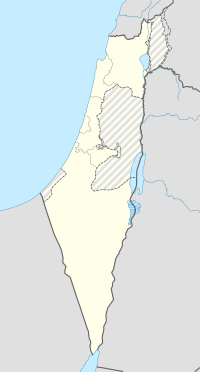Khirbat al-Minya

The ruins of the Minya palace, 2009
|
|
| Alternate name | Ayn Minyat Hisham, Hurvat Minim |
|---|---|
| Coordinates | 32°51′54″N 35°32′10″E / 32.864884°N 35.536223°E |
| Type | palace |
| History | |
| Builder | Umayyad ruler |
| Founded | 8th century |
| Abandoned | 8th century, later reused |
| Site notes | |
| Public access | Yes |
Khirbat al-Minya (also known as Ayn Minyat Hisham or Hurvat Minim) is an Umayyad-built palace in the eastern Galilee, Israel, located about 200 meters (660 ft) west of the northern end of Lake Tiberias. It was erected as a qasr complex, with a palace, mosque, and bath built by a single patron.
The site is the only Umayyad ruin in Israeli territory with remains above the ground and features one of the earliest mosques in Palestine.
Khirbat al-Minya was likely built during the reign of the Umayyad caliph al-Walid I (705-715 CE) and an inscription on a stone found at the site mentions his name. The supposed patron of the palace was al-Walid's son 'Umar ibn al-Walid, who served as the governor of Tiberias during his father's reign, but fell out of favor when his uncle Sulayman ibn Abd al-Malik assumed the role of caliph. This makes the palace's mosque one of the earliest to be built in Palestine.
Khirbat al-Minya served a number of purposes, including as local administrative center for a subregion of the Jund al-Urdunn ("District of Jordan") and as a contact point for 'Umar and local Arab tribes. It also could have served as a caravanserai for merchants traveling along the Sea of Galilee or northeast from the lake shore to the coast. Another purpose of Khirbat al-Minya was a winter retreat for the governor of Tiberias or an alternative for the traditional summer retreat for the governor at Baysan.
Khirbat al-Minya was abandoned at an uncertain date, but was later temporarily resettled. There is evidence that the palace was in use until at least the end of the Umayyad period in 750 CE. A strong earthquake hit the region, probably in the 749 Galilee earthquake. This damaged the building, causing a rift to run through the eastern wing, going straight through the mosque's mihrab. The damage in the niche were never repaired. It thus remains uncertain whether the palace was ever finished: Fallen debris from the earthquake was discovered in the 20th century in situ on the floor tiles of the main entry. The unused raw materials of a mosaic builder were found in the antechamber of the mosque.
...
Wikipedia

